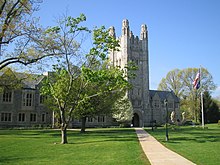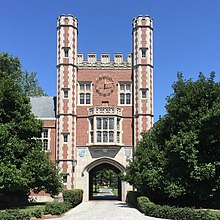Allen & Collens
The firm was best known as the designers of Gothic Revival buildings, including the Union Theological Seminary campus and Riverside Church in New York City.
[1] About the same time J. Lawrence Berry and Harold Buckley Willis became partners, though the firm continued as Allen & Collens.
Berry had worked for Allen at the turn of the century before opening his own office, though he frequently associated with the firm on individual projects, such as the Marlborough City Hall.
His independent works included the North Hampton Library and St. Luke's and St. Margaret's Church, the latter as a member of the firm of Berry & Davidson.
[8][1] The firm was renamed Allen, Collens & Willis c. 1934 when they were joined by architect Edward A. Hubbard, a former partner of Henry Forbes Bigelow.
The École des Beaux-Arts curriculum centered plan and composition, with a strong emphasis on architectural history, as the foundational elements of design.
[12] Allen & Collens' major work in the Neoclassical style was the monumental William Oxley Thompson Memorial Library of Ohio State University.
[13] They developed a national reputation for their Gothic Revival work, which included the Thompson Memorial Library (1905) of Vassar College and the Union Theological Seminary campus (1910) and Riverside Church (1930) in New York City.
Like other Beaux-Arts architects they were stylistically flexible and often adapted to the genius loci of a site, such as at Bowdoin College, where Collens found that only the Colonial style was appropriate,[14] or in the First Parish Church (1933) of Waltham, where they channeled the Greek Revival style of the church's 1838 building.
[1] In 1875, Allen married and bought a house lot on Fairfield Street in the Back Bay.
[22] This experience apparently triggered a career shift, and that year he left his father's business to enter the Massachusetts Institute of Technology (MIT) architecture school.
[1] After a year at MIT he spent another in Paris, studying in the Beaux-Arts atelier of Joseph Auguste Émile Vaudremer.
In 1900 he traveled to Paris and joined the atelier of Jean-Louis Pascal, and he was admitted to the École des Beaux-Arts in September.
Held by the Department of Drawings & Archives, Avery Architectural & Fine Arts Library, Columbia University.























